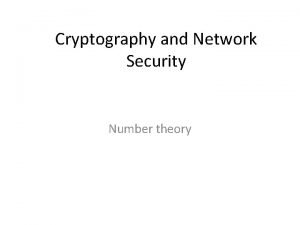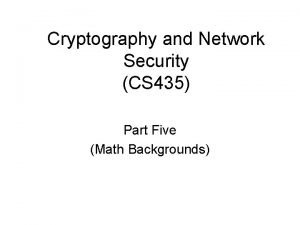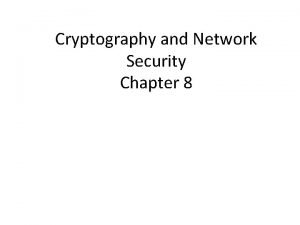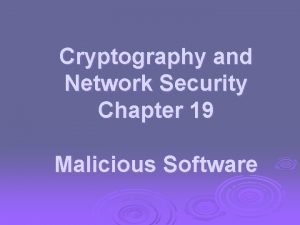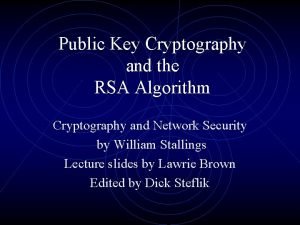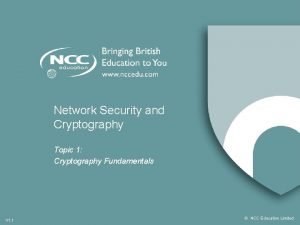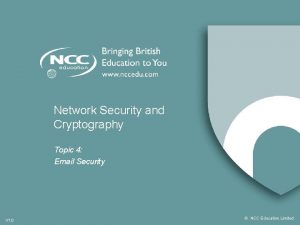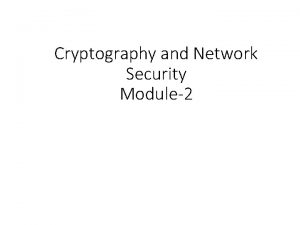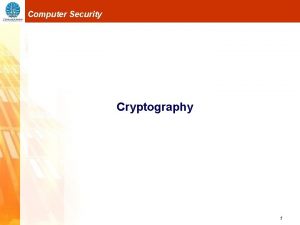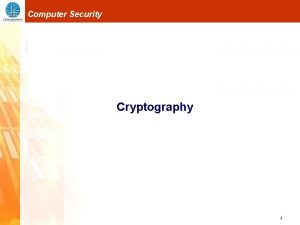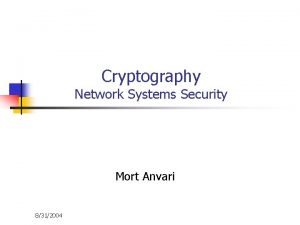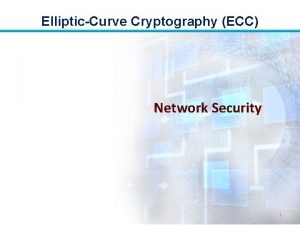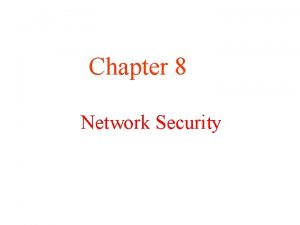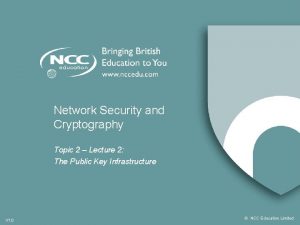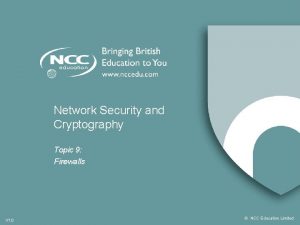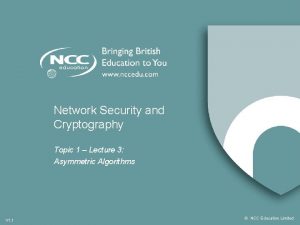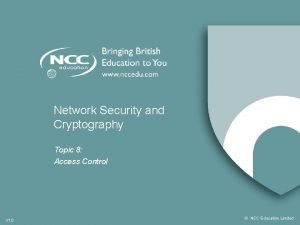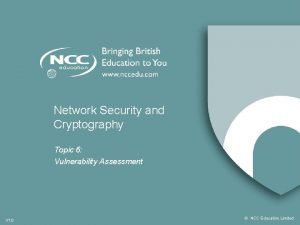Network Security and Cryptography Topic 1 Cryptography Fundamentals





























- Slides: 29

Network Security and Cryptography Topic 1: Cryptography Fundamentals V 1. 1 © NCC Education Limited

Network Security and Cryptography Topic 1 – Lecture 1: Module Overview & Overview of Security V 1. 1 © NCC Education Limited

Cryptography Fundamentals Topic 1 - 1. 3 Scope and Coverage This topic will cover: • • • V 1. 1 Introduction to module Overview of security Overview of cryptography Block ciphers Public-key ciphers Hash algorithms © NCC Education Limited

Cryptography Fundamentals Topic 1 - 1. 4 Learning Outcomes By the end of this topic students will be able to: • Explain the most common types of cryptographic algorithm (i. e. block ciphers, public-key ciphers and hash algorithms) • Select and justify an appropriate algorithm for a particular purpose V 1. 1 © NCC Education Limited

Cryptography Fundamentals Topic 1 - 1. 5 Module Aims • This module will provide you with the underlying theory and practical skills required to secure networks and to send data safely and securely over network communications (including securing the most common Internet services). V 1. 1 © NCC Education Limited

Cryptography Fundamentals Topic 1 - 1. 6 Module Syllabus - 1 • • V 1. 1 Cryptography Fundamentals Public-Key Infrastructure Web Security Email Security Data Protection Vulnerability Assessment Authentication © NCC Education Limited

Cryptography Fundamentals Topic 1 - 1. 7 Module Syllabus - 2 • • • V 1. 1 Access Control Firewalls VPN Remote Access Wireless Security © NCC Education Limited

Cryptography Fundamentals Topic 1 - 1. 8 Module Delivery • The teacher-led time for this module is comprised of lectures and laboratory sessions. • Lectures are designed to start each topic. - You will be encouraged to be active during lectures by raising questions and taking part in discussions. • Laboratory sessions are designed to follow the respective topic lecture. - During these sessions, you will be required to work through practical tutorials and various exercises. V 1. 1 © NCC Education Limited

Cryptography Fundamentals Topic 1 - 1. 9 Private Study • You are also expected to undertake private study to consolidate and extend your understanding. • Exercises are provided in your Student Guide for you to complete during this time. V 1. 1 © NCC Education Limited

Cryptography Fundamentals Topic 1 - 1. 10 Assessment • This module will be assessed by: - an examination worth 50% of the total mark - an assignment worth 50% of the total mark V 1. 1 © NCC Education Limited

Cryptography Fundamentals Topic 1 - 1. 11 Computer Security – Definition • “The protection afforded to an automated information system in order to attain the applicable objectives of preserving the integrity, availability and confidentiality of information system resources (includes hardware, software, firmware, information/data, and telecommunications). ” National Institute of Standards and Technology, Special Publication 800 -12, (October 1995). V 1. 1 © NCC Education Limited

Cryptography Fundamentals Topic 1 - 1. 12 Cryptography – Definition • “The discipline that embodies the principles, means, and methods for the transformation of data in order to hide their semantic content, prevent their unauthorized use, or prevent their undetected modification. ” National Institute of Standards and Technology, Special Publication 800 -59, (August 2003). V 1. 1 © NCC Education Limited

Cryptography Fundamentals Topic 1 - 1. 13 Security Objectives • NIST gives three objectives (FIPS 199): - Confidentiality: Preserving authorized restrictions on information access and disclosure, including means for protecting personal privacy and proprietary information. - Integrity: Guarding against improper information modification or destruction, including ensuring information non-repudiation and authenticity. - Availability: Ensuring timely and reliable access to and use of information. V 1. 1 © NCC Education Limited

Cryptography Fundamentals Topic 1 - 1. 14 Loss of Security • The following defines a loss of security in each objective: - Loss of Confidentiality: Unauthorized disclosure of information. - Loss of Integrity: Unauthorized modification or destruction of information. - Loss of Availability: Disruption of access to or use of information or information systems. V 1. 1 © NCC Education Limited

Cryptography Fundamentals Topic 1 - 1. 15 The CIA Triad • These requirements (Confidentiality, Integrity, Availability) are commonly known as the CIA triad. • There are many critiques that suggest that this does not provide a complete picture of security requirements. • The two most commonly cited “extra” requirements are: - Authenticity - Accountability V 1. 1 © NCC Education Limited

Cryptography Fundamentals Topic 1 - 1. 16 Authenticity • Being genuine, verified and trusted. • Confidence in the validity of: - A transmission - A message originator • Verifying that users are who they say they are and that each message came from a trusted source. V 1. 1 © NCC Education Limited

Cryptography Fundamentals Topic 1 - 1. 17 Accountability • Actions of an entity can be traced uniquely to that entity. • Supports: V 1. 1 Non-repudiation Deterrence Fault isolation Intrusion detection and prevention Recovery Legal action © NCC Education Limited

Cryptography Fundamentals Topic 1 - 1. 18 OSI Security Architecture • ITU-T Recommendation X. 800, Security Architecture for OSI, provides a systematic way for: - Defining the requirements for security - Characterising the approaches to satisfying those requirements • ITU-T stands for ‘International Telecommunication Union Telecommunication Standardization Sector’ • OSI stands for ‘Open Systems Interconnection’ V 1. 1 © NCC Education Limited

Cryptography Fundamentals Topic 1 - 1. 19 OSI Security Architecture • The following concepts are used: - Security attack: Any actions that compromise the security of information owned by an organisation (or a person). - Security mechanism: a mechanism that is designed to detect, prevent, or recover from a security attack. - Security service: a service that enhances the security of the data processing systems and the information transfers of an organisation. The services make use of one or more security mechanisms to provide the service. V 1. 1 © NCC Education Limited

Cryptography Fundamentals Topic 1 - 1. 20 Security Attacks • It is useful to categorise attacks as: - Passive attacks - Active attacks • Passive attacks make use of information from a system but do not affect the system resources. • Active attacks alter system resources or affect their operation. V 1. 1 © NCC Education Limited

Cryptography Fundamentals Topic 1 - 1. 21 Passive Attacks • Release of message contents: The information in a message is read. • Traffic analysis: message information cannot be read but traffic patterns are analysed to glean information. V 1. 1 © NCC Education Limited

Cryptography Fundamentals Topic 1 - 1. 22 Active Attacks • Masquerade: one entity pretends to be another entity. • Replay: passive capture of data and its retransmission to produce an unauthorized effect. • Message modification: a message is altered to produce an unauthorized effect. • Denial of service: preventing or hindering the use of network resources. V 1. 1 © NCC Education Limited

Cryptography Fundamentals Topic 1 - 1. 23 Security Services • A security service is a service which ensures adequate security of the systems or of data transfer. • X. 800 Recommendation divides security services into 5 categories: - V 1. 1 Authentication Access control Data confidentiality Data integrity Non-repudiation © NCC Education Limited

Cryptography Fundamentals Topic 1 - 1. 24 Security Mechanisms • Security mechanisms are used to implement security services. They include: - V 1. 1 Encipherment Digital signature Access Control mechanisms Data Integrity mechanisms Authentication Exchange Traffic Padding Routing Control Notarisation © NCC Education Limited

Cryptography Fundamentals Topic 1 - 1. 25 Number Theory • Many public-key cryptosystems use non-trivial number theory. • The RSA public-key cryptosystem is based on the difficulty of factoring large numbers. • We will outline the basic ideas of: - divisors - prime numbers - modular arithmetic V 1. 1 © NCC Education Limited

Cryptography Fundamentals Topic 1 - 1. 26 Divisors and Prime Numbers • Divisors - Let a and b be integers where b is not equal to 0 - Then we say b is a divisor of a if there is an integer m such that a = mb; • Prime numbers - An integer p is a prime number if its only divisors are 1, -1, p, -p V 1. 1 © NCC Education Limited

Cryptography Fundamentals Topic 1 - 1. 27 GCD & Relatively Prime Numbers • Greatest Common Divisor (gcd) - gcd(a, b) is a greatest common divisor of a and b (the largest number that divides into both numbers) - Examples: • gcd(12, 15) = 3 • gcd(49, 14) = 7 • Relatively Prime Numbers - a and b are relatively prime if gcd(a, b) = 1 - Example: gcd (9, 14) = 1 V 1. 1 © NCC Education Limited

Cryptography Fundamentals Topic 1 - 1. 28 Modular Arithmetic • If a is an integer and n is a positive integer, we define a mod n to be the remainder when a is divided by n: - Example, 10 mod 3 = 1 • If (a mod n) = (b mod n), then a and b are congruent modulo n • (a mod n) = (b mod n) if n is a divisor of a-b V 1. 1 © NCC Education Limited

Network Security and Cryptography Topic 1 – Lecture 2: Overview of Cryptography V 1. 1 © NCC Education Limited
 Wireless security in cryptography
Wireless security in cryptography Security guide to network security fundamentals
Security guide to network security fundamentals Security guide to network security fundamentals
Security guide to network security fundamentals Security guide to network security fundamentals
Security guide to network security fundamentals Modulo table
Modulo table Introduction to cryptography and network security
Introduction to cryptography and network security Number theory in cryptography and network security
Number theory in cryptography and network security Firewall in cryptography and network security
Firewall in cryptography and network security Authentication in cryptography and network security
Authentication in cryptography and network security Intruders in cryptography
Intruders in cryptography Primitive root in cryptography
Primitive root in cryptography Cryptography and network security 6th edition pdf
Cryptography and network security 6th edition pdf Pearson cryptography and network security
Pearson cryptography and network security Source
Source Cryptography and network security 4th edition
Cryptography and network security 4th edition Fermat's theorem in cryptography and network security
Fermat's theorem in cryptography and network security Multiplicative inverse
Multiplicative inverse Digital signature in cryptography and network security
Digital signature in cryptography and network security Modular arithmetic in cryptography and network security
Modular arithmetic in cryptography and network security Pgp in cryptography and network security
Pgp in cryptography and network security Euler's theorem in cryptography and network security
Euler's theorem in cryptography and network security Malicious software in cryptography
Malicious software in cryptography Introduction to cryptography and network security
Introduction to cryptography and network security Rsa algorithm in cryptography and network security
Rsa algorithm in cryptography and network security Introduction to cryptography and network security
Introduction to cryptography and network security Private security
Private security Cryptography fundamentals
Cryptography fundamentals The osi security architecture
The osi security architecture Electronic mail security in network security
Electronic mail security in network security Example of a clincher
Example of a clincher















